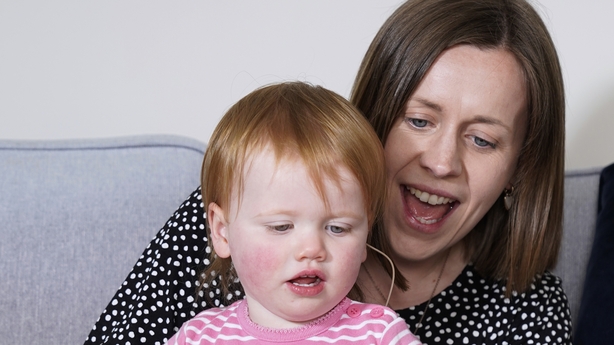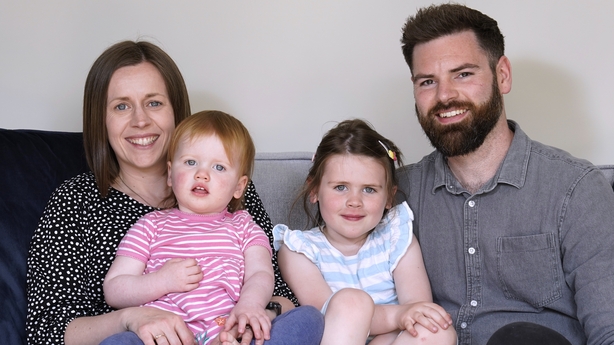A British girl has had her hearing restored after becoming the first person in the world to take part in a groundbreaking new gene therapy trial.
Opal Sandy, aged 18 months, was born completely deaf due to the condition auditory neuropathy, which is caused by the disruption of nerve impulses travelling from the inner ear to the brain.
Now, thanks to a “one and done” gene therapy being trialled in the UK and worldwide, Opal’s hearing is almost normal – and could even improve further.
The little girl, from Oxfordshire in England, who has a genetic form of auditory neuropathy, was treated at Addenbrooke’s Hospital, which is part of Cambridge University Hospitals NHS Foundation Trust.
Professor Manohar Bance, an ear surgeon at the trust and chief investigator for the trial, told the PA news agency the results were “better than I hoped or expected” and may cure patients with this type of deafness.
He said: “We have results from (Opal) which are very spectacular – so close to normal hearing restoration. So we do hope it could be a potential cure.”
Auditory neuropathy can be caused by a fault in the OTOF gene, which is responsible for making a protein called otoferlin. This enables cells in the ear to communicate with the hearing nerve.
To overcome the fault, the “new era” gene therapy – from biotech firm Regeneron – delivers a working copy of the gene to the ear.
In Opal’s case, she received an infusion containing the working gene to her right ear during surgery last September.
Her parents Jo and James noticed improvements to her hearing in just four weeks, but the results were particularly impressive 24 weeks later.
Prof Bance said: “In terms of being able to hear soft sounds (like a soft whisper), she can hear almost normal for her age.

“Now, we don’t know that she can understand speech in the same way because she’s too young, but certainly she can respond to soft sounds.”
Prof Bance said Opal’s hearing is now “close to normal”, adding: “We hope she’ll get back to normal by the next testing.”
He added that the treatment is “a one and done therapy, so hopefully you have your treatment and then you go back to your life”.
A second child has also received the gene therapy treatment at Cambridge University Hospitals, with positive results seen recently, six weeks after surgery.
The overall phase 1/2 Chord trial consists of three parts, with three deaf children, including Opal, receiving a low dose of gene therapy in one ear only.
A different set of three children will get a high dose on one side. Then, if that is shown to be safe, more children will receive a dose in both ears at the same time.
Up to 18 youngsters from the UK, Spain and the US are being recruited to the trial and will be followed-up for five years.
Regarding the success of Opal’s case, Prof Bance said: “My entire life, gene therapy has been ‘five years away’, and I’ve been in practice about 30 years.
“So, for me, it was almost unreal that this moment had arrived.
“It was just the fact that we’ve been hearing about this for so long, and there’s been so much work, decades of work.. to finally see something that actually worked in humans….It was quite spectacular and a bit awe-inspiring really.
“It felt very special.”
At the moment, the gold standard treatment for auditory neuropathy is cochlear implants.
Opal had one fitted to her left ear at the same time as she underwent gene therapy in her right ear, to ensure she got hearing as soon as possible.
However, according to Prof Bance, implants can have limitations such as difficulty filtering out background noise when multiple people are speaking.
As a result, scientists have been working on experimental gene therapies to advance the field.
Opal is the first patient globally to receive the Regeneron therapy and “she’s the youngest globally that’s been done to date as far as we know,” Prof Bance said.
China has also been working on targeting the same gene, with positive results, though Prof Bance said theirs uses a different technology and slightly different mode of delivery.

Medics in Philadelphia have also reported a good outcome with a type of gene therapy on an 11-year-old boy, who was operated on after Opal.
Prof Bance said he believes the trial is “just the beginning of gene therapies”, adding: “It marks a new era in the treatment for deafness.
“It also supports the development of other gene therapies that may prove to make a difference in other genetic-related hearing conditions, many of which are more common than auditory neuropathy.”
He said it could take a while for more children to benefit from gene therapy, depending on how quickly the trial can enrol patients, costs to the NHS and whether it can be scaled up.
Opal’s surgery, which was carried out under general anaesthetic, was very similar to fitting a cochlear implant, Prof Bance continued.
“So basically, we find the inner ear and we open the inner ear and we infuse the treatment, in this particular case using a catheter, over 16 minutes.
“We have to make a release hole in another part of the ear to let the treatment out because it has to go all the way through the ear.
“And then we just repair and close up, so it’s actually a very similar approach to a cochlear implant, except we don’t put the implant in.”
The gene therapy used in the Chord trial is called DB-OTO and is specifically for children with OTOF mutations.
A modified and harmless virus is used to carry the working gene, enabling genetic material to be delivered to specific cells to restore hearing function.
Prof Bance estimates that around 20,000 people in the US, Germany, France, Italy, Spain and the UK have auditory neuropathy due to OTOF mutations.
Children with a variation in the OTOF gene are born with severe to profound hearing loss, but they often pass the newborn hearing screening tests and people think they can hear.
Martin McLean, senior policy adviser at the National Deaf Children’s Society, said: “Many families will welcome these developments, and we look forward to learning about the long-term outcomes for the children treated.
“This trial will teach us more about the effectiveness of gene therapy in those cases where deafness has a specific genetic cause.
“We would like to emphasise that, with the right support from the start, deafness should never be a barrier to happiness or fulfilment.
“As a charity, we support families to make informed choices about medical technologies, so that they can give their deaf child the best possible start in life.”
Results from the Chord study were presented yesterday to the American Society of Gene and Cell Therapy conference in Baltimore in the US.
Source link
 TG4 TV PC to TV
TG4 TV PC to TV
